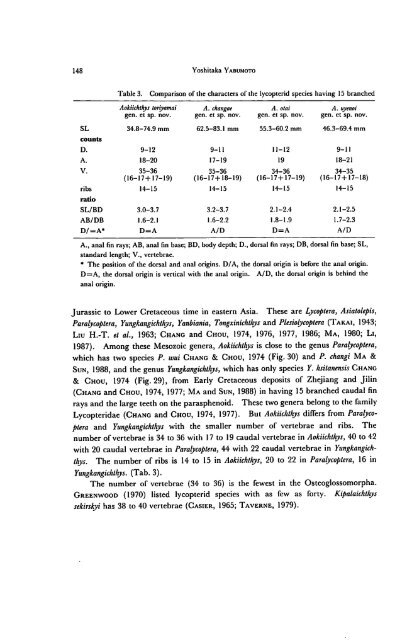Early Cretaceous Freshwater Fish Fauna in Kyushu, Japan
Early Cretaceous Freshwater Fish Fauna in Kyushu, Japan
Early Cretaceous Freshwater Fish Fauna in Kyushu, Japan
You also want an ePaper? Increase the reach of your titles
YUMPU automatically turns print PDFs into web optimized ePapers that Google loves.
148 Yoshitaka Yabumoto<br />
Table 3.<br />
Comparison of the characters of the lycopterid species hav<strong>in</strong>g 15 branched<br />
Aokiichthys toriyamai<br />
gen. et sp. nov.<br />
A. changae<br />
gen. et sp. nov.<br />
A. otai<br />
gen. et sp. nov.<br />
A. uyenoi<br />
gen. et sp. nov.<br />
SL 34.8-74.9 mm 62.5-83.1 mm 55.3-60.2 mm 46.3-69.4 mm<br />
counts<br />
D. 9-12 9-11 11-12 9-11<br />
A. 18-20 17-19 19 18-21<br />
V.<br />
35-36<br />
(16--17+17-19)<br />
35-36<br />
(16-17+18-19)<br />
34-36<br />
(16-17+17-19)<br />
34-35<br />
(16-17 + 17-18)<br />
ribs 14-15 14-15 14-15 14-15<br />
ratio<br />
SL/BD 3.0-3.7 3.2-3.7 2.1-2.4 2.1-2.5<br />
AB/DB 1.6-2.1 1.6-2.2 1.8-1.9 1.7-2.3<br />
D/=A* D=A A/D D=A A/D<br />
A., anal f<strong>in</strong> rays; AB, anal f<strong>in</strong> base; BD, bodydepth; D., dorsal f<strong>in</strong> rays; DB,dorsal f<strong>in</strong> base; SL,<br />
standard length; V., vertebrae.<br />
* The position of the dorsal and anal orig<strong>in</strong>s. D/A, the dorsal orig<strong>in</strong> is before the anal orig<strong>in</strong>.<br />
D=A, the dorsal orig<strong>in</strong> is vertical with the anal orig<strong>in</strong>. A/D, the dorsal orig<strong>in</strong> is beh<strong>in</strong>d the<br />
anal orig<strong>in</strong>.<br />
Jurassic to Lower <strong>Cretaceous</strong> time <strong>in</strong> eastern Asia. These are Lycoptera, Asiatolepis,<br />
Paralycoptera, Yungkangichthys, Yanbiania, Tongx<strong>in</strong>ichthys and Plesiolycoptera (Takai, 1943;<br />
Liu H.-T. et al, 1963; Chang and Chou, 1974, 1976, 1977, 1986; Ma, 1980; Li,<br />
1987). Among these Mesozoic genera, Aokiichthys is close to the genus Paralycoptera,<br />
which has two species P. wui Chang & Chou, 1974 (Fig. 30) and P. changi Ma &<br />
Sun, 1988, and the genus Yungkangichthys, which has only species Y. hsitanensis Chang<br />
& Chou, 1974 (Fig. 29), from <strong>Early</strong> <strong>Cretaceous</strong> deposits of Zhejiang and Jil<strong>in</strong><br />
(Chang and Chou, 1974, 1977; Ma and Sun, 1988) <strong>in</strong> hav<strong>in</strong>g 15 branched caudal f<strong>in</strong><br />
rays and thelarge teeth on theparasphenoid. These two genera belong to the family<br />
Lycopteridae (Chang and Chou, 1974, 1977). But Aokiichthys differs from Paralyco<br />
ptera and Yungkangichthys with the smaller number of vertebrae and ribs. The<br />
number of vertebrae is 34 to 36 with 17 to 19 caudal vertebrae <strong>in</strong> Aokiichthys, 40 to 42<br />
with 20 caudal vertebrae <strong>in</strong> Paralycoptera, 44 with 22 caudal vertebrae <strong>in</strong> Yungkangich<br />
thys. The number of ribs is 14 to 15 <strong>in</strong> Aokiichthys, 20 to 22 <strong>in</strong> Paralycoptera, 16 <strong>in</strong><br />
Yungkangichthys. (Tab. 3).<br />
The number of vertebrae (34 to 36) is the fewest <strong>in</strong> the Osteoglossomorpha.<br />
Greenwood (1970) listed lycopterid species with as few as forty. Kipalaichthys<br />
sekirskyi has 38 to 40 vertebrae (Casier, 1965; Taverne, 1979).

















